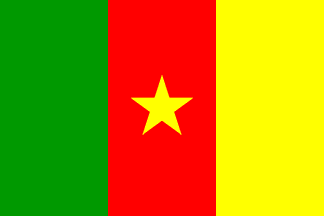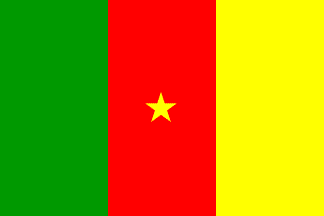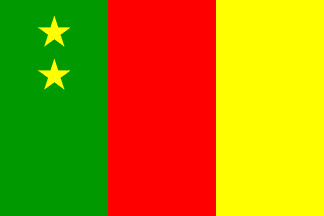
![[National Flag and Ensign]](../misc/oooooo.gif) 2:3~
2:3~by Željko Heimer, 13 October 2001
Flag adopted 20 May 1975, coat of arms adopted in 1984.

Last modified: 2008-09-06 by zeljko heimer
Keywords: cameroon | cameroun | africa | panafrican colours | star (yellow) | crab | stars: 2 |
Links: FOTW homepage |
search |
disclaimer and copyright |
write us |
mirrors

![[National Flag and Ensign]](../misc/oooooo.gif) 2:3~
2:3~
by Željko Heimer, 13 October 2001
Flag adopted 20 May 1975, coat of arms adopted in 1984.
Vertical tricolor green red yellow, with a yellow
fivepointed star in the middle. Cameroon is second modern African state
(after Ghana) to adopt panafrican colours. When British South Cameroon
joined federation, two stars where added. In 1972, the country became a unitary state and three years later two stars where replaced with just one. The flag was officially hoisted on 20 May 1975. Proportions are aprox. 2:3. (based on [smi82])
Željko Heimer 8 December 1995
Red, yellow and green are the pan-African colours
and the pattern of the flag recalls the French Tricolore. Green stands
for hope and the Southern forests, red for unity (and the star as well
is the star of unity) and yellow for the sun ('the source of people
happiness') or prosperity as well as the Northern savannas. ([udk97],
[smi75c], [ped71])
Ivan Sache, 13 February 2000
In 'DTV-Lexikon politischer Symbole', 1970, Arnold Rabbow [rab70] writes:
'Green represents the rich vegetation of the southern region; yellow the
soil of the extreme North; the red stands for national sovereighnty.'
Mucha - Webster's concise Encyclopedia of Flags, 1985 [mch85a]:
'Green denotes the rich forest vegetation of the southern part of the
country, and the hope for a happy future; red is the symbol of
independence and unity; and yellow stands for the savannas in the
savannas in the northern part of the country and for the sun as the
source of the nation's happiness. The star symbolizes the unity of the
country.'
Jarig Bakker, 13 February 2000
The colours of the flag of Cameroon are the pan-African colours,
green/red/yellow. They are based on the colours of the flag of
Ethiopia, a horizontal tri-colour of green/yellow/red which dates
back to 1897. The colours of the Cameroon flag form a vertical
tri-colour based on the flag of France which was the colonial
power controlling most of its territory before independence.
The basic pattern of the flag of Cameroon dates back to 1957. In
1961 Southern Cameroon, a former British colony or dependency,
voted to join Cameroon in a federal type of government. At that
time two yellow stars were added to the upper part of the green
portion of the flag. In 1972 the federal system was replaced by
a unitary government, and in 1975 the two stars were removed from
the green and a single yellow star was placed on the red portion
of the flag.
Devereaux D. Cannon, Jr., 27 February 2001
Vagnat & Poels 2000 book [vap00] gives Article 1(5) from the Constitution
last amended in 1996 which describes (but does not detail) the current flag.
The last legislation I have is Law No 84-1 dated 4 February 1984 (issued on the
basis of the 1972 Constitution as amended), but this also contains no details
regarding a size for the star.
Christopher Southworth 18 August 2003
The Constitution of the Republic of Cameroon was adopted on 2 June 1972 and last changed by Law #96/06 of 18 January 1996:
Part ICited from [vap00] by Ivan Sache 23 August 2003
On the State and Sovereignty
Article 1
[...]
4. The motto of the Republic of Cameroon is: PEACE - WORK - FATHERLAND
5. Its flag shall be: green, red, yellow in three equal vertical stripes. It is charged with one gold star in the centre of the red stripe.
[...]
7. The seal of the Republic of Cameroon shall be a circular medallion in bas-relief, 46 millimetres in diameter, bearing on the obverse and in the centre the head of a girl in profile turned to the dexter towards a coffee branch with two leaves and flanked on the sinister by five cocoa pods, encircled beneath the upper edge by the French words "Republique du Cameroun" and above the lower edge by the national motto "Paix - Travail - Patrie"; on the reverse and in the centre the coat of arms of the Republic of Cameroon, encircled beneath the upper edge by the English words "Republic of Cameroon" and above the lower edge by the national motto "Peace - Work - Fatherland".
The coat of arms of the Republic of Cameroon shall be an escutcheon surmonted chief by the legend "Republic of Cameroon" and supported two crossed fasces with the motto "Peace - Work - Fatherland" base. The escutcheon shall be composed of a gold star or on a field vert and triangle gules, charged with the geographical outline of Cameroon azure and surcharged with the sword and scales of justice sable.
[...]
The local paper yesterday carried a picture from Reuters of flags outside the Commonwealth Heads Of Government Meeting in Malta. The Cameroun flag, clearly visible in the display, has a much larger star than shown above - it looks like it takes up 7/8 of the width of the central stripe, or maybe more.
James Dignan, 29 November 2005

by Ivan Sache, 15 February 2008
The football Nations' Africa Cup (CAN) took place in Ghana from 20 January to 10 February 2008. Two big national flags were consistently hung from the stand during the matches. Those of Cameroon were characterized by a very small star, hardly visible from a distance. I can add to this report that I saw several flag during a visit in Yaoundé in autumn 2004, hoisted over official buildings or sold in the streets, with no unformity in the star size. Ivan Sache, 15 February 2008

by Željko Heimer, 13 October 2001
The 1961-75 flag of Cameroon was a vertical tricolour of green-red-yellow with two yellow stars on the red. It was adopted when the former British territory of Southern Cameroon voted to join French Cameroun which became independent in 1957. The 2 stars signified the two territories. In 1972 Cameroon became a unitary state and the second star was subsequently dropped from the flag.
Stuart Notholt 30 November 1995
Pedersen's The International Flag Book in Color of 1971 shows the flag of Cameroon as a vertical tricolor of green-red-yellow with two gold (darker yellow then the third vertical) stars in the upper half of the green.
Michael Smuda, 20 July 1998
Look at a copy of Whitney Smith's 1975 book Flags Through the Ages and Across the World and you'll see the current Cameroon flag (one star) in the section on flags of the world, and you'll find the obsolete two-starred version in the "flying flags" painting at the front of the book. The design of the flag changed in 1975 during the production of that book.
Nick Artimovich, 20 July 1998

by Vincent Morley, 25 May 1997
The September 1961 issue of the 'National Geographic' magazine contains an article about
the flags of the 99 states which were then UN members. They write: "Cameroun citizens last year
adopted an unadorned tricolor: green for the luxuriant vegetation of the south, red for
soverereignty, and yellow for the sunshine of this African nation's northern region. Joined U.N. 1960."
Jarig Bakker 18 August 2003
It was in fact adopted by Law 46 dated 29 Octuber 1957. Confirmed by the constitution
21 Feb 1960 (independence was 1 January 1960). The flag with two stars replaced it on 1 October 1961
(but designed before, in April), and that was in turn replaced with a single star flag on 20 May 1975.
Jaume Olle 18 August 2003
Christian Fogd Pedersen gives the dates for the plain tricolour as 1957-1961.
Christopher Southworth 18 August 2003
I think it probable that this badge, described by Jaume, was not a
badge of Southern Cameroons until after it had become a region of the
Republic of Cameroon which has two official languages, English as well as
French.
David Prothero, 4 May 2000